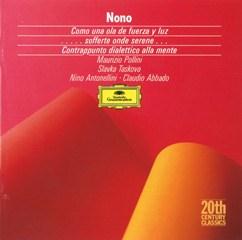Luigi Nono - Como una Ola, Sofferte Onde Serene (1988)
Luigi Nono - Como una Ola, Sofferte Onde Serene (1988)

Como Una Ola De Fuerza Y Luz 1 Beginning 2:33 2 I. Interno Dolce 1:47 3 II. Duro Deciso 2:14 4 Piano Entry 6:55 5 III. Dolcissimo Sereno 2:11 6 Orchestra Entry 10:02 7 Orchestra And Piano Entry 4:20 8 ....Sofferte Onde Serene.... 13:58 9 Contrappunto Dialettico Alla Mente 19:51 Slavka Taskova (soprano) Maurizio Pollini (piano) Symphonie-Orchester des Bayerischen Rundfunks Claudio Abbado (conductor) Liliana Poli (soprano) (tracks: 9) Berliner Philharmoniker (tracks: 9) Coro Da Camera Della RAI, Roma (tracks: 9) Giuseppe Sinopoli (conductor) 'Como Una Ola De Fuerza Y Luz' for soprano, piano, orchestra and tape, composed in 1971-1972 '...Sofferte Onde Serene...' for piano and tape, composed in 1976. 'Contrappunto Dialettico Alla Mente' for 2-channel tape, composed in 1968.
Luigi Nono began Como una ola de fuerza y luz (Like a wave of strength and light) as a piece for piano and orchestra in 1971, at the instigation of Maurizio Pollini. While the composition was in progress, Nono learned of the death of a young Chilean revolutionary and recast the work in his memory, with added parts for soprano soloist and tape. The resulting half hour work is clearly a lament, encompassing various expressions of grief, from stunned sorrow to anguish to the fiercest rage. As a kind of requiem, the work is deeply expressive and deeply moving. Claudio Abbado leads the Symphonieorchester des Bayerischen Rundfunks in an overwhelming performance, made soon after the work's premiere. Soprano Slavka Taskova and Pollini sing and play with great passion and commitment.
Scored for piano and tape, ...sofferte onde serene (...serene waves suffered, 1976) was also written for Pollini. Like Como una ola de fuerza y luz, it has the character of a lament, but is more subdued, without the larger work's anguished outcry. The piece commemorates deaths of relatives of the composer's and the pianist's, and its overall mood of serene resignation is punctuated with clangorous clusters reminiscent of the tolling of bells. A third piece for tape, Contrappunto dialettico alla mente (1968), takes as its sound sources voices singing, speaking, and shouting, using texts by revolutionary poets and an American anti-war pamphlet. The composer describes the work as being inspired by a madrigal comedy written in 1608 by Adriano Banchieri, but it's difficult to discern any clear connection to musical conventions of the early Baroque. Instead, it's a spookily evocative indictment of the political injustices Nono deplored. The strong performances make the disc a fine introduction to some of Nono's most expressive and impassioned work. ---Stephen Eddins, AllMusic Review
...In Como una ola defuerzay luz (1971-72), the engineering is still more intricate and inventive. Indeed it's the very substance of the piece, for in the traditional sense there is little enough 'composing' involved: the tensions which sustain the affair arise from juxtapositions of blocks of sound much more than from patterns of notes. Maurizio Pollini dispatches the piano part—much hammering of repeated notes—with great rhetorical flair, which is all that it requires. (It does at least do something to disguise the rhythmic invertebracy of the whole piece.) Both Pollini's contribution and that of the soprano soloist, Slavka Taskova, are subjected to various electronic transformations and fed back into the score. After several hearings, I find that the sheer sumptuousness of the sound still compels admiration. Musically there is scarcely anything that demands one's attention, but I can imagine that on a suitable occasion either piece might make rather a splendid, decadent effect. --- Gramophone, arkivmusic.com
download (mp3 @320 kbs):
yandex mediafire uloz.to gett my-files.ru








